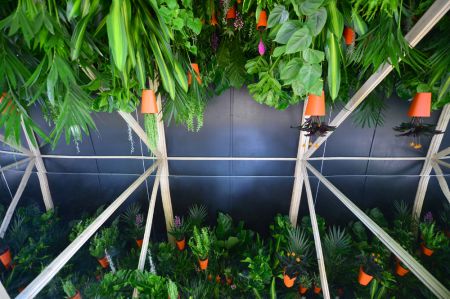How Our Upside-Down Garden Is Turning Perceptions On Their Heads
We’re delighted to be working once again with award-winning garden designer John Warland to help us talk about the remarkable transformation in Ethiopia in the 30 years since the famine. Below, he reveals the inspiration behind the first of three World Vision gardens: the 'upside-down’ aid crate currently on view at Chelsea Flower Show.

By John Warland, Senseless Acts of Beauty
For the last few years I've sponsored Ronald, a young boy in Bolivia, and after meeting him in person in 2012, I stuck one of my photos of him on the fridge at home.
Creating a garden from scratch – nothing more than an idea in your mind – takes long hours of hard work, and this was definitely the case while constructing the 'upside down' garden that's currently showing at the RHS Chelsea Flower Show.
But seeing the smiling face of my sponsored child on my kitchen fridge every morning and evening helped me focus on what the hard grind is all about. I even visited him in 2012 and it drove home just how important World Vision’s work is.
A trilogy
I was delighted when World Vision approached me to create a trilogy of gardens to remember the 30th anniversary of the Ethiopian famine. As they explained the transformation in the region - particularly in the Antsokia Valley – I was amazed. All I could remember is the barren dustbowl from the news reports in the 1980s. Back then it was a place where nothing grew, but now it is a vibrant oasis from where produce is exported around the world.
Famine - and aid - is a difficult issue to illustrate sensitively so I took the concept of the journey of a simple shipping crate and used this as a basis to show the change in the region over three decades.
The installation at Chelsea is the first of three gardens that will evolve with a second at BBC Gardener’s World Live in Birmingham and culminate in a final garden in the glorious setting of Hampton Court Palace in early July.
 When BBC reporters Michael Burke and Michael Wooldridge (left) arrived in the country in 1984, the Government wasn't allowing foreigners in, but World Vision made space for them in a plane that was delivering food aid to stricken areas in the north of the country.
When BBC reporters Michael Burke and Michael Wooldridge (left) arrived in the country in 1984, the Government wasn't allowing foreigners in, but World Vision made space for them in a plane that was delivering food aid to stricken areas in the north of the country.
This allowed the correspondents to make the moving reports that brought the famine to global media attention (and triggered the formation of Live Aid).
First drops
When the first large waves of aid relief began arriving, much of it was distributed by airdrops to remote locations, and it is these first relief efforts that informed my work.
As the aid crates fell to earth, they were full of basic food, water, medicines and supplies to give shelter. However, I imagined for a moment that they also offered a sign of hope, that victims of famine were not forgotten.
More than that, the crates also signified a promise that alongside immediate vital aid, World Vision would support the region over the long-term to the self-sustaining lush landscape that it is today.
 The idea behind the first installation is that a crate has fallen uninvited into the RHS Chelsea showground where it rests upside down. An orange parachute is tangled in a tree and the front of the crate has fallen open to reveal a world of inverted plants hanging from the ceiling.
The idea behind the first installation is that a crate has fallen uninvited into the RHS Chelsea showground where it rests upside down. An orange parachute is tangled in a tree and the front of the crate has fallen open to reveal a world of inverted plants hanging from the ceiling.
Amongst the foliage there are edibles in the form of tomatoes, coffee, cucumbers, ginger and lettuce to symbolise what Ethiopians are now harvesting.
Step further towards the crate and you will begin to notice the mirrored interior. The reflected plants appear to go to infinity, representing the fact that although the aid crates were instant relief, there was indeed much more to come.
RHS Chelsea signals the start of the “summer season”, attracting the Queen and a host of celebrities from Jo Whiley and Helen Mirren to Rowan Atkinson and Michael McIntyre. So an installation like this is a great way to encourage discussion about serious issues and celebrate the work of World Vision.
We received a Silver medal from the judges for the garden and it's great to hear how much people are enjoying it. The faces of visitors as they walk past and discover the “upside down garden" are just priceless.
As the first “site-specific” piece at the show, you might need to come and hunt to find us. Look for the orange parachute caught in the tree, and if all else fails we’re just past the Pimms Tent on the left!
Share your questions for John in the comments below and we’ll put them to him and share them with you in a later post. Find out more about the Grow Hope campaign and the rest of this year's gardens on our Grow Hope page.